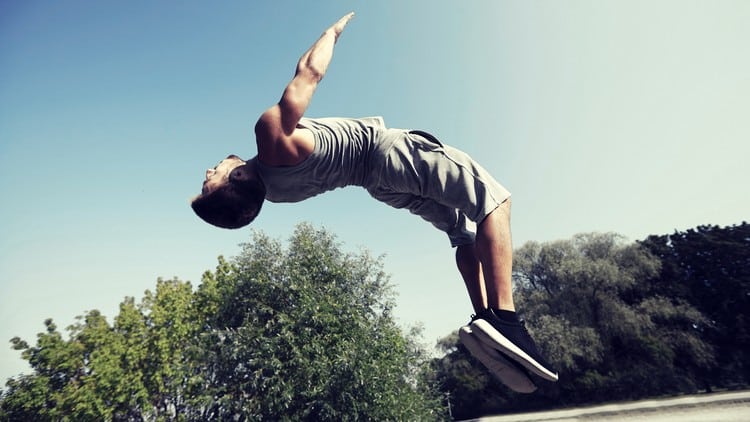Are you ready to take your acrobatic skills to the next level? Learning how to do a backflip is an exhilarating journey that can lead to impressive feats of athleticism and showmanship. In today’s world, where physical fitness and entertainment are highly valued, mastering the backflip can open doors to countless opportunities.
In this article, we’ll guide you through the steps to perform a backflip safely and confidently. Let’s take that first exciting leap into the world of acrobatics.
Ready to flip? Let’s go!

Table of contents
The Three Phases of How to Do a Backflip
When learning how to do a backflip, it’s crucial to understand that this acrobatic move can be broken down into three distinct phases, each requiring its unique set of skills and techniques.
#1. The Setup Phase: Preparing for Takeoff
First, position yourself on a flat, open surface, preferably with a soft landing area, such as a gymnastics mat or foam pit. To start, stand with your feet shoulder-width apart. Here’s where the journey begins.
To initiate the backflip, bend your knees slightly, preparing to push off. With your arms raised above your head, take a deep breath to stay relaxed.
As you exhale, swing your arms downward while springing into the air. This sequence of movements, which leads to your takeoff, is the foundation of your backflip.
Importantly, never jump backward. Instead, focus on jumping upward. This distinction can make a world of difference in the success of your backflip. Keep this in mind as you embark on your journey to master this acrobatic move.
See also: How To Do Ghost Inhale? Fun Vaping Tricks for Beginners
#2. The Airborne Phase: Tucking and Rotating
As you soar into the air, transitioning from the setup to the airborne phase, your body needs to adapt. This is where the tuck and rotation come into play.
To ensure a smooth flip, tuck your knees towards your chest while keeping your eyes focused on the ground. This compact position reduces your body’s surface area, facilitating a faster rotation. Simultaneously, keep your arms close to your body to maintain control and balance. It’s like turning into a human ball in mid-air.
The flip occurs naturally as you tuck and rotate. Keep your head tucked in and maintain a tucked position until you see the ground coming into view. This phase may seem daunting, but with practice and confidence, it becomes more manageable.
See also: How to Do a Burnout in a Front Wheel Drive Car
#3. The Landing Phase: Sticking the Landing
The final phase is landing your backflip safely. As you spot the ground, begin to extend your body, gradually straightening your legs and arms. Prepare for a gentle touchdown.
Upon landing, ensure that you land on the balls of your feet first, followed by your heels. This helps in absorbing the shock and maintaining your balance. Your body should remain slightly bent to cushion the landing further.
Use your arms to assist in balance and stability. Focus on landing softly and confidently, then celebrate your successful backflip.
See also: How to Do the Symmetrical Challenge Instagram
How to Spot a Backflip
When watching someone perform a backflip, it’s essential to understand how to spot this acrobatic move safely. To spot effectively, you must remain vigilant and provide support while keeping these steps in mind.
First, position yourself at a vantage point where you can observe the backflip clearly. Ideally, stand to the side, slightly behind the person attempting the flip.
Next, keep a keen eye on the key phases we discussed earlier – the setup, airborne, and landing phases. As the person bends their knees to prepare for takeoff, ensure they maintain good posture, staying upright and balanced.
During the airborne phase, pay attention to their tuck and rotation. Check that their movements are controlled, and they’re tucked into a tight ball, spinning smoothly.
As they approach the landing phase, be ready to assist if necessary. Encourage them to land on the balls of their feet, offering guidance and support for a safe and soft landing.
By understanding how to spot a backflip, you contribute to a safer and more enjoyable acrobatic experience for everyone involved.
See also: Why do Dogs Lick Each Other’s Ears?
FAQs
It depends on your skill set, but if you are learning both as a new skill, a backflip is easier physically but it is harder to learn as many people have trouble getting over the fear of jumping backward without seeing where they are going, a frontflip is harder to land though.
Time will vary based on body type and athleticism. With a coach helping to communicate proper technique a backflip on the trampoline could be learned relatively easily, 1–3 sessions. Learning a standing backflip will vary greatly on body type and athleticism.
If you practice with the correct form. Your backflip will be perfected much more quickly. Some people can learn it in a day, others take months, and some never learn it. The people that learn it are typically the ones who have effort, and perseverance.
Conclusion
Knowing how to do a backflip is a thrilling endeavor that offers not only physical prowess but also a sense of achievement.
Remember the three phases, practice diligently, and ensure a safe environment with proper spotting.
So, what are you waiting for? Take that leap of faith, and soon you’ll be flipping with confidence and grace. Happy backflipping!
References
- Leggendarystrength.com – How to do a Backflip
- Acon24.com – How to do a Backflip – top tips





